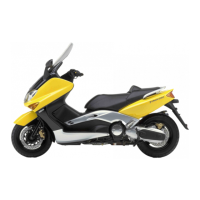
Do you have a question about the Yamaha XP500 TMax and is the answer not in the manual?
| Engine Type | Liquid-cooled, 4-stroke, DOHC, 4-valve |
|---|---|
| Compression Ratio | 10.9:1 |
| Fuel System | Fuel Injection |
| Ignition System | TCI |
| Transmission | V-Belt Automatic |
| Rear Suspension | Swingarm |
| Front Brake | Dual hydraulic disc |
| Front Tire | 120/70-15 |
| Rear Tire | 160/60-15 |
| Seat Height | 800 mm |
| Wet Weight | 220 kg |
| Overall Length | 2, 200 mm |
| Overall Width | 775 mm |
| Overall Height | 1, 420 mm |
| Wheelbase | 1, 575 mm |
| Ground Clearance | 125 mm |
| Front Suspension | Telescopic fork |
| Rear Brake | Hydraulic disc |
| Fuel Tank Capacity | 15.0 L |
Lists key engine components and technologies for the TMax superscooter.
Highlights frame, suspension, wheels, and ergonomic features of the chassis.
Details lighting, instrumentation, and electrical accessory provisions.
Provides detailed specifications and technical features of the TMax engine.
Details valve train components, camshaft specifications, and valve timing.
Describes the cylinder body, liquid cooling, and left-side cam chain drive.
Explains the crankshaft, horizontally opposed balancer, and bearing system.
Details combustion and balancer piston features, including V-groove and dimensions.
Describes the connecting rods used for combustion and the balancing system.
Explains the CVT system, V-belt, cooling, and transmission filters.
Details the wet multi-plate centrifugal clutch, spring type, and gear reduction ratio.
Covers the final drive chain, swingarm integration, and gear ratio calculation.
Describes the semi dry sump system, oil pump, cooler, and oil capacity.
Illustrates the oil flow path for scavenging and feeding pumps.
Details the radiator, pump, fan, and thermostat operation for engine cooling.
Lists carburetor settings and auto-choke electrical control logic.
Describes the air filter case, noise reduction box, and induction system.
Details the 2-into-1 stainless exhaust pipes and muffler assembly.
Covers the high-rigidity chassis, frame design, and dimensional references.
Describes the fuel tank location, capacity, and aerodynamically styled bodywork.
Details windscreen protection and seat design with adjustable backrest.
Outlines front and rear storage compartment sizes and features.
Explains front fork, rear shock absorber, and swingarm design.
Details wheel, tire, and brake caliper specifications for front and rear.
Covers generator capacity and the design of the dual multi-reflector headlight.
Details taillight assembly, lean angle switch, and accessory pre-wiring.
Describes the instrument panel layout, speedometer, and indicator lights.
Provides guidance on checking engine oil, final drive, and coolant levels.
Details CO adjustment, air induction system, and access for related components.
Identifies components under the rear cowl and outlines V-belt replacement.
Explains timing checks, valve adjustment precautions, and oil indicator reset.
Lists specialized tools required for clutch and bearing maintenance procedures.
Details primary/secondary sheave removal and main bearing replacement.
Provides a schedule for regular checks, adjustments, and lubrication intervals.
Details the electrical wiring schematic and its component color codes.
